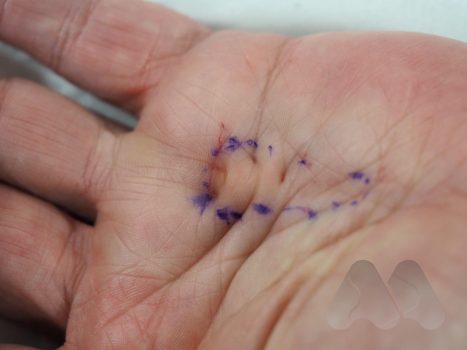What is it?
Dupuytren’s disease is pronounced “doop – atren” and is a benign (non cancerous) condition causing a thickening of the gristle tissue under the skin in the palm. The disease can extend into the fingers. It can cause a progressive bending of the fingers into the palm. It usually does not cause pain although some patients can describe pain over the thickened nodules. The most common digits affected are the ring and little fingers.
It is more common in Anglo-Saxon men and has a strong family inheritance but can affect many different types of people. Ask your father or grandfather if they developed curled fingers?
A younger age of onset less than 40 years or involvement of the thumb or index finger can signal a more aggressive form of the disease. In rare forms of the disease, it can affect the soles of the feet (Ledderhose disease) or male genital region (Peyronie disease) where the condition is called Dupuytren’s diathesis.
What should I do about it?
In the early stages of Dupuytren’s disease where there is no contracture of the fingers, usually no treatment is required. If there are signs of aggressive disease features then at these early stages, radiotherapy has been shown to be an effective treatment to prevent progression. For most people, treatment is only recommended when the palm cannot be pushed flat on the table which often coincides with the fingers causing trouble in day to day life. You may notice difficulty wearing gloves, putting your hands in pockets and washing your face.
Treatment Options Include
- Percutaneous needle fasciotomy
- Xiaflex or collagenase injection
- Fasciectomy
- Dermofasciectomy and skin graft
Which treatment is the best?
Each of the treatments are appropriate and have excellent results for the right patient. Factors to consider are your age, affected digit, severity of disease and general medical health.
Percutaneous needle fasciotomy is generally a rooms-based procedure where the tight cord in the palm is released with a needle to allow the finger to straighten. The procedure does not remove the disease and therefore there is a high rate of recurrence of 85% at 5 years. as such, this treatment is usually reserved for the elderly where recurrence is not a major problem.
Xiaflex is an FDA approved prescription medication of collagenase clostridium histolyticum and non-surgical treatment for Dupuytren’s disease. It acts to breakdown the affected cords in the palm and finger and allows manipulation of the finger allowing it to straighten.










